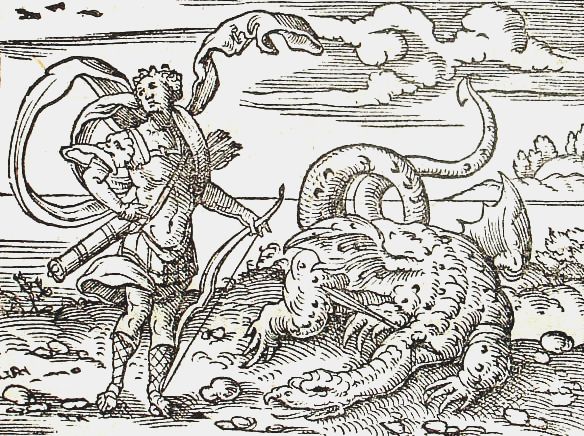Dragons
Dragons played a significant role in Greek myths, often guarding treasures or serving as fearsome opponents for heroes.
Colchian Dragon
Parents: Gaia and Typhon
Offspring: Spartoi
Killed by: Jason and Medea
Coiled within the sacred grove of Ares in Colchis, this monstrous guardian dwarfed even the mightiest warriors. Its scales, the color of polished obsidian, shimmered with a menacing sheen, a constant reminder of the legendary Golden Fleece it fiercely protected.

When Jason and the Argonauts arrived, seeking the fleece, they knew they would have to confront the dragon. But King Aeetes, the land’s cunning ruler, had a different plan. Before the beast faced Jason’s blade or Medea’s magic (depending on the tale), Aeetes saw power in the dragon’s very essence. He harvested the creature’s teeth, each one a glistening shard imbued with potent magic.
These teeth, pulsating with a dangerous energy, became Jason’s first challenge. Aeetes commanded Jason to sow them in a sacred field, a final test before the hero could face the dragon itself. From the earth, under the watchful gaze of Ares, sprouted not crops, but a terrifying army – the Spartoi, warriors born from the dragon’s teeth, each one a formidable foe.
Hesperian Dragon
Parents: Phorcys and Ceto
Killed by: Heracles
This monstrous guardian, tasked with protecting the golden apples of the Hesperides, defied imagination. Coiled around the tree, his hundred serpentine heads swiveled ceaselessly, each one a venomous threat. His scales, the color of twilight, shimmered with an otherworldly sheen, reflecting the forbidden fruit he guarded. Legends whispered that Ladon never slept.

When Heracles arrived to claim the golden apples as one of his Twelve Labors, he knew he faced a formidable foe. The ensuing battle was a clash of wills – Heracles’ raw strength against Ladon’s hundredfold fury. In the end, the demigod prevailed, but the victory wasn’t without a cost. The death throes of Ladon echoed through the garden, a chilling reminder of the power and perils that guarded even the most tempting treasures.
Lydian Dragon
Killed by: Damasen
This monstrous beast dwelled within the depths of the River Hermus, its serpentine form a menacing presence in the land of Lydia. The dragon terrorized the region, but a hero named Damasen rose to the challenge. In a fierce battle, he managed to slay the beast, bringing a temporary respite to the people. However, the story doesn’t end there. The Lydian Dragon’s mate, driven by grief and a powerful magic, possessed a mythical herb. This potent botanical treasure, imbued with the life force of the earth itself, held the power to cheat death. With a desperate ritual, the mate revived the fallen dragon, restoring its reign of terror.
Ismenian Dragon
Parents: Ares
Offspring: Spartoi
Killed by: Cadmus
Coiling around the sacred spring of Ares near Thebes, it embodied raw, primal power. Its scales, the color of dried blood, glistened menacingly, a constant reminder of the god of war it served.

When Cadmus, a hero seeking to found a city, arrived at the spring, he unknowingly stumbled upon a conflict. A fierce battle ensued, with Cadmus, fueled by determination, wielding a heavy stone against the monstrous serpent. In the end, the hero emerged victorious, the dragon’s reign of terror finally over.
Guided by the wisdom of Athena, Cadmus sowed the dragon’s teeth into the earth. From this macabre act of creation sprang forth the Spartoi – a terrifying crop of fully-grown, armed warriors. These warriors, born from the very essence of war, were destined to fight amongst themselves, and only five would remain to become the founders of Thebes.
Ares, the god of war, wouldn’t let this transgression go unpunished. In a cruel twist of fate, he transformed Cadmus and his wife into serpents, forever bound to the land they sought to tame.
Thespian Dragon
Killed by: Menestratus
The Thespian Dragon was a terrifying serpent that ravaged the land of Boeotia. Its immense form cast a shadow of fear, its hunger insatiable. Each year, the desperate Thespians offered a young life as appeasement, but when fate threatened a beloved citizen, Menestratus stepped forward. In a selfless act of love, he donned a spiked breastplate and launched himself into the dragon’s jaws, becoming a living weapon to save his city.
Medean Dragons
They were a pair of serpents which drew the flying chariot of the witch Medea. She summoned them to carry her away from Corinth following the murder of King Creon, his daughter Glauce and her children by Jason.

Trojan Dragons
Parents: Typhon
From the churning depths, Athena summoned a pair of monstrous serpents, their bodies the size of ships and their scales reflecting an unnatural green. These leviathans, instruments of divine wrath, were sent to silence Laocoön, the Trojan seer who dared to speak against the seemingly harmless wooden horse. Their arrival marked the tragic turning point for Troy, a chilling reminder that even the wisest voices can be silenced by the fury of the gods.

Python
Parents: Gaia
Killed by: Apollo
A monstrous serpent named Python, guardian of the Delphic oracle, embodied the earth’s primal power. Some say Apollo, seeking the oracle’s secrets, slew Python with a volley of arrows. Others whisper vengeance for his mother, relentlessly pursued by the beast. Whatever the reason, Python’s demise marked the rise of Apollo’s Delphic oracle, forever linked to the serpent’s name – Pytho – a chilling reminder of the power that lay beneath the earth and the battles fought for prophecy and dominion.

